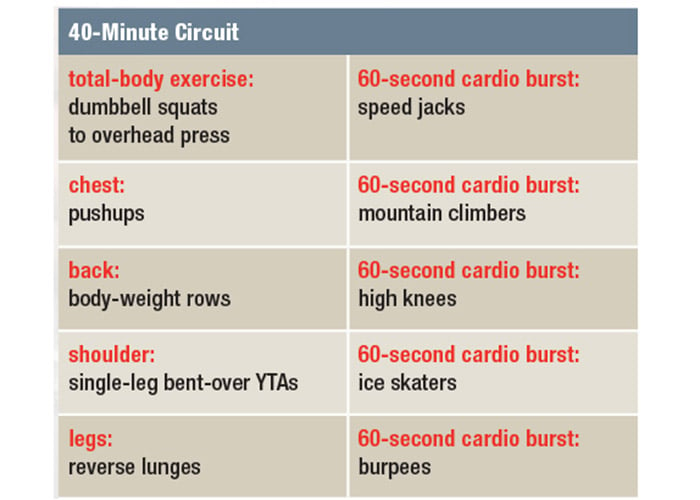By Rick Richey
As seen in our weight loss specialization course, you can effectively utilize the OPT™ model for weight loss clients. Within this article from the Spring 2020 Issue of American Fitness Magazine, you will learn how!
Consider a client named Jordan. She is in her late 50s and has tried all kinds of diets and various workouts, but even when she succeeded, the weight crept back. You’re a big supporter of the NASM Optimum Performance Training™ model, but you’re fairly certain that Jordan won’t be happy if you drag out a foam roller at the start of her first session.Her main goal, she has told you in no uncertain terms, is to lose weight—20 pounds, to be exact.
Unfortunately, many weight loss clients (and the fitness professionals who train them) wonder why they should spend time on things like assessments, self-myofascial release, flexibility training and corrective exercise. These activities do not burn tons of fat or energy, so their value is not immediately obvious when weight loss is the goal. (How to help clients reframe their goals in terms of health and other nonscale improvements is a discussion for another day.)
However, good trainers are defined, not by their ability to help clients burn copious amounts of calories, but by their skill in aiding clients to reach their goals safely, effectively and efficiently. The NASM OPT™ model is designed for exactly that, when used in its entirety. This means following all of the model’s progressions and guidelines with everyone, even clients who are hyperfocused on a single outcome.
MAXIMIZE FAT LOSS WITH CREATIVE PROGRAMMING
The easiest way to build more calorie-burning into a training session is to teach clients to do self-myofascial release, stretching and muscle activations on their own. This way, a trainer can plan a full 60-minute exercise routine for trainer and client to do together in the gym. But due to physical limitations, time constraints or poor adherence, this may not be workable for all clients. In these cases, there are some simple ways to increase a session’s metabolic demands and leave plenty of time for those important “extras.”
Let’s look at what we can do to maximize fat loss in the 40-minute workout portion of a 60-minute session of Phase 1 Stabilization Endurance training—while still allowing for a 10-minute warmup and a 10-minute cooldown.
MAKE EVERY SECOND COUNT WITH CIRCUITS
Resting after each set is an extremely common practice, but it limits the total amount of work and metabolic demands placed on the body during a specific time frame. Circuit training limits the rest interval until after completion of a predefined series of exercises, thereby shortening overall rest time throughout the session.
Circuits can be done in a relatively short amount of time and still provide excellent benefits. Kirk et al. (2009) designed a resistance training program that increased metabolic effect and energy expenditure in just 11 minutes. Even in this short time (11 minutes!), an increase in energy expenditure can favorably affect body composition. I am not suggesting limiting resistance training to 11 minutes, but you could triple or quadruple that duration and still have time for assessments, foam rolling, stretching, core, balance and other components of exercise programming.

HOW CIRCUITS EQUAL A GREATER CALORIE BURN
Here’s the math: During Phase 1 Stabilization Endurance training, each repetition is performed at a slow tempo (4/2/1), so each rep lasts approximately 7 seconds. Since the repetition range is 12–20, the total time per set is 84–140 seconds. Translation: A single 20-rep exercise equals roughly 2.5 minutes of continuous resistance training.
A typical vertical-load circuit may include the following types of exercises prior to resting: total body, chest, back, shoulders and legs. If all five of these exercises are done at a 4/2/1 tempo for 20 reps each, the series provides a total of 700 seconds (11 minutes 40 seconds) of exercise. Do the series three times through, and you’re at 35 minutes. Even with a few seconds of “transitional” rest when switching between exercises, this leaves nearly 25 minutes for other activities.
WHAT RESEARCH SAYS ABOUT A SLOW TEMPO
In a 2012 study, Mukaimoto & Ohno used a four-exercise circuit, which participants performed in three ways: slow tempo, low intensity; normal tempo, low intensity; and normal tempo, high intensity (each protocol had its own day). VO2 consumption was measured continuously throughout each exercise session and for 180 minutes after.
There was no difference in excess postexercise oxygen consumption (EPOC) after the workouts were complete, but during the slow-tempo circuit, participants consumed significantly more oxygen than they did during the other exercise sessions. As oxygen is a vital component in metabolism, this indicates that the slow-tempo circuit produced greater caloric expenditure than either of the other two formats.

BOOST THE BURN WITH MINI CARDIO BURSTS
If you want to make metabolic expenditure even greater, you can add a 60-second cardio burst at the end of each set in the strength training circuit. This increases metabolic expenditure, boosts intensity, and results in higher heart rate spikes during the workout. Plus, it adds only 5 minutes to the total circuit time. This cardio-enhanced circuit—three times through—takes 40 minutes to complete, is incredibly challenging for all clients and still leaves 10 minutes before and after for warmup and cooldown. It also allows the resistance tempo requirements of the NASM OPT model to stay intact. See the sample workout below for how this might look in practice.
KEEP CLIENTS SAFE WHILE LOSING WEIGHT
The NASM OPT model is a smart system designed to fine-tune the whole body, not just parts of it. This helps to keep your weight loss clients safe—and focused on more than burning calories.
SAMPLE PHASE 1: STABILIZATION ENDURANCE CIRCUIT WITH MINI CARDIO BURSTS
This circuit allows for stabilization, endurance and metabolic outcomes to be accomplished on all fronts. Remember to have clients do each set to fatigue, which can be voluntary (“I think I should stop there”) or observed (you see that a client cannot
perform the exercise again without compensation). Keep in mind that this program allows for 20 minutes of a 60-minute session to be split between a warmup and a cooldown.

MYTH BUSTER: FAT BURN AND EXERCISE INTENSITY
Weight loss clients often have preconceived notions and misperceptions about what strategies work (or don’t). That’s why the NASM Weight Loss Specialization (1.9 NASM CEUs) provides insights into numerous myths and what science says about them.
One such example covered in the WLS textbook is this: “You have to exercise at a low intensity, or you won’t burn fat.” According to the book, this has a “distorted grain of truth” in it.
“During exercise of low intensity, there is a higher percent contribution from fat as a fuel source. However, this is offset by the higher energy expenditure during high-intensity exercise” (NASM, p. 97). The table below makes these relationships easier to see:

In a study by Miller et al. (2014), eight obese men completed a 30-minute high-
intensity circuit training workout three times per week for 4 weeks (a total of 6 hours of exercise). Data analyses before and after HICT revealed a 3.6% decrease in fat tissue percentage over the course of the study, as well as reductions in resting heart rate, systolic blood pressure, cholesterol, insulin and other metrics.
The major difference between this workout and an NASM OPT™ model Phase 1
workout is that the tempo in the study group was as fast as could be performed. With
this in mind, keeping slow resistance training while getting creative with programming
—varying intensity and other factors—could increase metabolic demands.
To learn more about the Weight Loss Specialization program, visit nasm.org/products/ceu161k.
REFERENCES
Kirk, E.P., et al. 2009. Minimal resistance training improves daily energy expenditure and fat oxidation. Medicine & Science in Sports & Exercise, 41 (5), 1122–29.
Miller, M.B., et al. 2014. The effect of a short-term high-intensity circuit training program on work capacity, body composition, and blood profiles in sedentary obese men: A pilot study. Biomed Research International. doi: 1155/2014/191797.
Mukaimoto, T., & Ohno, M. 2012. Effects of circuit low-intensity resistance exercise with slow movement on oxygen consumption during and after exercise, Journal of Sports Sciences, 30 (1), 79–90.

